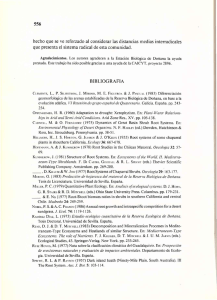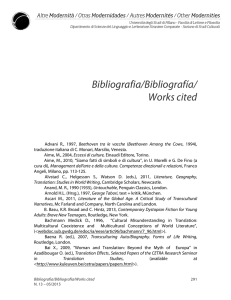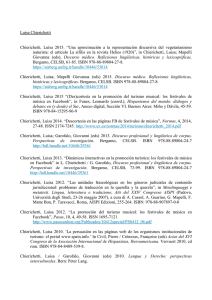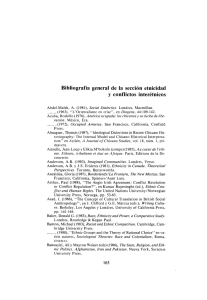El Imperio asirio - Desperta Ferro Ediciones
Anuncio
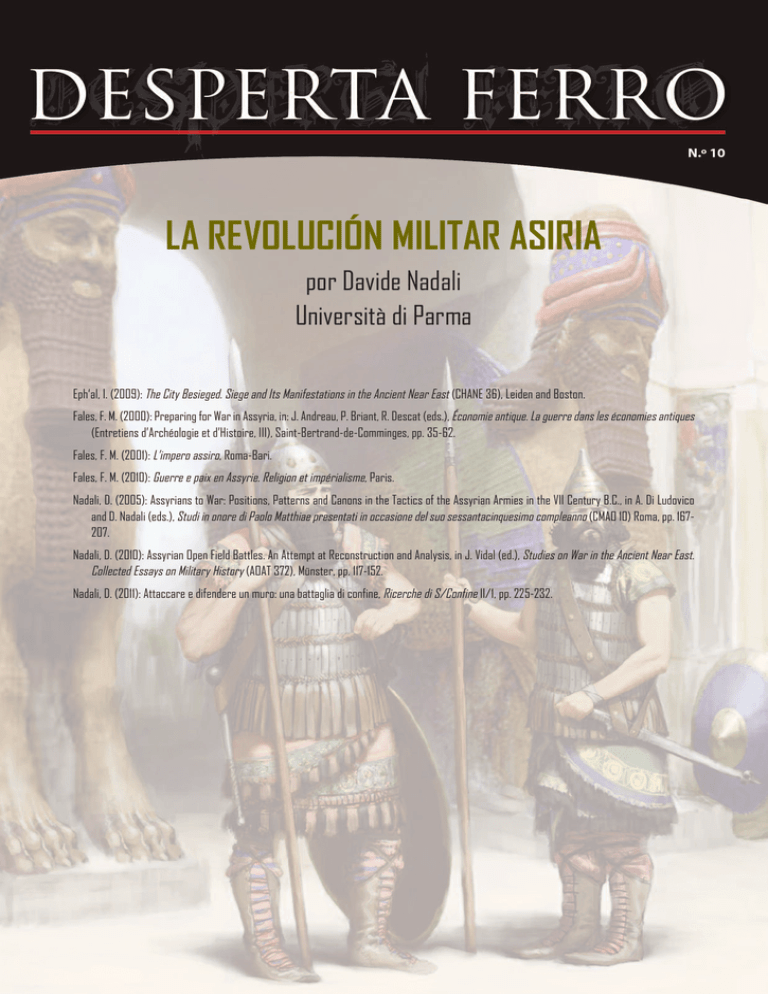
La revoLución miLitar asiria por Davide Nadali Università di Parma Eph‘al, I. (2009): The City Besieged. Siege and Its Manifestations in the Ancient Near East (CHANE 36), Leiden and Boston. Fales, F. M. (2000): Preparing for War in Assyria, in: J. Andreau, P. Briant, R. Descat (eds.), Économie antique. La guerre dans les économies antiques (Entretiens d’Archéologie et d’Histoire, III), Saint-Bertrand-de-Comminges, pp. 35-62. Fales, F. M. (2001): L’impero assiro, Roma-Bari. Fales, F. M. (2010): Guerre e paix en Assyrie. Religion et impérialisme, Paris. Nadali, D. (2005): Assyrians to War: Positions, Patterns and Canons in the Tactics of the Assyrian Armies in the VII Century B.C., in A. Di Ludovico and D. Nadali (eds.), Studi in onore di Paolo Matthiae presentati in occasione del suo sessantacinquesimo compleanno (CMAO 10) Roma, pp. 167207. Nadali, D. (2010): Assyrian Open Field Battles. An Attempt at Reconstruction and Analysis, in J. Vidal (ed.), Studies on War in the Ancient Near East. Collected Essays on Military History (AOAT 372), Münster, pp. 117-152. Nadali, D. (2011): Attaccare e difendere un muro: una battaglia di confine, Ricerche di S/Confine II/1, pp. 225-232. DeL carro a La cabaLLería en asiria por Fernando Quesada Sanz Universidad Autónoma de Madrid ANTHONY, D.W. (2007) The Horse, the wheel and language. How Bronze-Age riders from the Eurasian steppes shaped the modern world. Princeton UP. ARCHER, R. (2010) “Chariotry to cavalry: developments in the Early First Millennium” En G.G. Fagan, M. Trundle (Eds.) New Perspectives on Ancient Warfare, pp. 57-79. Leiden, Brill. AZZAROLI, A. (1985) An early History of Horsemanship. Leiden. AZZAROLI, A. (1998) “Outlines of early equitation”. P Anreiter et al.(eds.), Man and the Animal world. Studies in memoriam S. Bökönyi, pp. 41-53. Budapest. COTTERELL, A. (2004) Chariot. The astounding rise and fall of the World’s first war machine. London, Pimlico. CROUWEL, J.H. (1978) “Aegean Bronze Age chariots and their Eastern background”. Bulletin of the Institute of Classical Studies 25, pp. 174-175. DALLEY, S. (1985) “Foreign chariotry and cavalry in the armies of Tiglath-Pileser III and Sargon II”. Iraq, 47, pp.31-48. DE BACKER, F. (2007) “Some basic tactics of the Neo-Assyrian Warfare”. Ugarit Forschungen 29, pp. 69-115. DREWS, R. (2004) Early riders. The beginnings of mounted warfare in Asia end Europe. London, Routledge. HROUDA, B. (1963) “Der Assyrische Streitwagen”. Iraq 25, pp. 155 ss. KELEKNA, P. (2009) The horse in human history. Cambridge, University Press. LITTAUER, M.A. (1969) “New light on the Assyrian chariot”. Orientalia 45, pp. 217-226. LITTAUER, M.A.; CROUWEL, J.H. (1979) Wheeled vehicles and ridden animals in the ancient Near East. Leiden. LITTAUER, M.A.; CROUWEL, J.H. (1991) “Assyrian trigas and Russian dvoikas”. Iraq 53, pp. 97-99. LITTAUER, M.A.; CROUWEL, J.H. (1996) “The origin of the true chariot”. Antiquity 70, pp. 934-939. MALBRAT-LABAT, F. (1982) L’armée et l’organisation militaire de l’Assyrie d’après les lettres des Sargonides trouvées à Ninive. Gèneve-Paris. MOOREY, P.R.S. (1986) “The emergence of the light, horse-drawn chariot in ther Near East c. 2000-1500 a.C.”. World Archaeology 18.2, pp. 196-215. NADALI, D. (2005) “Assyrians to war: positions, patterns and canons in the tactics of the Assyrian armies in the VII century BC”. A. Di Ludovico, D. Nadali (eds.) Studi in Onore Paolo Matthiae, pp. 167-207. Roma. NADALI, D. (2010) “Assyrian open field battles”. J.Vidal (ed.) Studies on War in the Ancient Near East. AOAT 372, pp. 117-152. Muster, Ugarit Vrlg.. NOBLE, D. (1990) “Assyrian Chariotry and Cavalry”. State Archives of Assyria Bulletin 4.1, pp. 61-68. OATES, J. (2003) “A Note on the Early Evidence for Horse and the Riding of Equids in Western Asia”. M.Devine, C.Renfrew,K.Boyle (eds.) Prehistoric Steppe Adaptation and the horse, pp. 115-125. Cambridge, McDonald Institute. OWEN,D.I. (1993) “The first equestrian: An UrIII glyptic scene.” Acta Sumerologica 13, pp. 259-273. POGREBOVA, M. (2003) “The Emergence of chariots and riding in the South Caucasus”. OJA 22.4, pp. 397-409. QUESADA SANZ, F. (2003) “La ley del péndulo. Armas, carros de guerra, tácticas y explicación histórica en el Antiguo Egipto y Oriente Próximo”. La guerra en Oriente Próximo y Egipto. Suppl. ad Isimu, 2, pp. 281-302. Madrid, UAM. QUESADA SANZ, F. (2005) “Carros en el antiguo Mediterráneo: de los orígenes a Roma”. E. galán (ed.) Historia del carruaje en España, pp. 16-71. Madrid, Cinterco. RAULWING, P. (ed.) (2002) Selected writings on Chariots, other Early vehicles, Riding and Harness by M.A. Littauer & J.H.Crouwel. Culture and History of the Ancient Near East 6. Leiden, Brill. SCHULMAN, A.R. (1957) “Egyptian representations of horsemen and riding in the new Kingdom” JNES 16, pp. 263-271. SCURLOCK, J. (1997) “Neo Assyrian Battle tactics”. G.D. Young, M.W. Chavalas, R.E. Averbeck (eds.) Crossing Boundaries and Living Horizons, pp. 491517. Betsheda. SPRUYTTE, J. (1977) Etudes expérimentelles sur l’attelage. Contribution à l’histoire du cheval. Paris. SPRUYTTE, J. (1993) “Le trige de guerre assyrien au IXe siècle avant J.C.”. Préhistoire et Anthropologie Méditerranéennes 2, pp. 193-200. STILLMAN, N.; TALLIS, N. (1984) Armies of the Ancient Near East, 3000 BC to 539 BC. Worthing, WRG. VAN DER STEDE, V. (2007) “Le cheval en Mésopotamie, des origines à l’époque néo-assyurienne”. P.Cattelain, N.Bozet (eds.) Sur la piste du cheval, de la Préhistorie à l’antiquité, pp. 55-69. CEDARC VITA, J.P. (2008) “Le char de guerre en Syrie et Palestine au Bronze Récent”. P. Abrahami, L. Battini (eds.) Les armées du Proche Orient ancient. BAR IS 1855, pp. 57-69. Oxford. YADIN, Y. (1963) The Art of Warfare in Biblical Lands in the Light of Archaeological Study. 2 vols. London. ZIVIE, A.P. (1985) “Cavaliers et cavalerie au Nouvel Empire: a propos d’un vieux problème”. Melanges à Gamal Mokhtar II, pp. 379-388. La guerra De aseDio en mesopotamia por Jordi Vidal Universitat Autònoma de Barcelona. Burke, A. A.,2008: ‘Walled Up to Heaven’: The Evolution of the Middle Bronze Age Fortification Strategies in the Levant. Winona Lake. Eph’al, I., 2009: The City Besieged. Siege and Its Manifestations in the Ancient Near East. Leiden / Boston. Fales, F. M., 2010: Guerre et paix en Assyrie: Religion et impérialisme. Paris. Herzog, C. / Gichon, M., 2003: Las batallas de la Biblia. Barcelona. Kern, P. B., 1999: Ancient Siege Warfare. Bloomington. Nadali, D., 2011: “Attaccare e difendere un muro: una battaglia di confine”, Richerche di S/Confine 2: 225-232. Ussishkin, D., 1982: The Conquest of Lachish by Sennacherib. Tel Aviv. Ussishkin, D., 1990: “The Assyrian Attack on Lachish: The Archaeological Evidence from the Southwest Corner of the Site”, Tel Aviv 17 (1990): 53-86. Vidal, J., 2009: “The Siege of Razama”, Altorientalische Forschungen 36: 365-371. Yadin, Y., 1963: The Art of Warfare in Biblical Lands. New York. DajjâLu: Los servicios De inteLigencia asirios por Fernando Espejel y Cristina López Regueiro Honggen, G., “The Assyrian Intelligence Activities”, Journal of Assyrian Academic Studies, 18/2, 2004. Lanfranchi, G.B., y Parpola, S. (eds)., The Correspondence of Sargon II, Part II. Letters from the Northern and Northeastern provinces, Helsinki University Press, Helsinki, 1987. Malbrant-Labat, F., L´armée et l´organisation militaire de L´assyrie. D´après letters des Sargonides trouvées a Ninive, Libraire Droz, Genève-Paris, 1982. Norman Brown, W., Shryock, J.K., Speiser E.A., (eds), State Letters of Assyria: A transliteration and Translation of 355 Official Assyrian Letters Dating from the Sargonid Period (722-625), New York, Connecticut, American oriental Society, 1935. Parpola, S., The Correspondence of Sargon II, Part I: Letters from Assyria and the West, Helsinki, Helsinki University Press, 1990 Zimansky, Paul, E., Ecology and Empire: The structure of the Urartian State, The University of Chicago, Chicago-Illinois, 1985. Córdoba, J. M., “Textos de la exposición “Urartu” ”, Cuadernos del Seminario Walter Andrae , nº 9, 2006-2007, pp. 59-90. Fales, F. M., L´impero assiro: storia e amministrazione (IX-VII secolo a.C.), Laterza, Roma, 2001. Kessler, K., “ “Royal Roads” and other Question of the Neo-assyrian Communication System” en Parpola, S. y Whiting, R.M., (eds), Assyria 1995. Proceedings of the 10th Anniversary Symposium of the Neo-Assyrian Texts Corpus Project, Helsinki University Press, Helsinki 1997, pp. 129- 136. Lucía Castejón, R., “Aššur frente a Urartu: Encrucijada en el reino de las montañas”, Cuadernos del Seminario Walter Andrae, nº 9, 2006-2007, pp. 21-31. Thureau-Dangin, F., Une relation de la huitième champagne de Sargon (714 av. J.-C.), Librairie Paul Geuthner, Paris, 1912. Salvini, M., “El reino de Urartu (El Ararat bíblico), Rival del imperio Asirio, Cuadernos del Seminario Walter Andrae, nº 9, 2006-2007, pp. 9-20. Wright, E.M., “The eight campaign of Sargon II of Assyria (714 B.C.)”, Journal of Near Eastern Studies, Vol 2, nº 3, 1943, pp. 173-186. Zimansky, Paul. E., “Urartian Geography and Sargon´s eight campaign” Journal of Near eastern Studies, Vol 49, nº 1, 1990, pp. 1-21. La caíDa DeL imperio neoasirio por Carmen del Cerro Universidad Autónoma de Madrid Andrae, W., Das wiedererstandene Assur, Leizpig, 1938. Fales, F.M., L’impero assiro. Editori Laterza, Roma-Bari, 2001. Frahm, E., “Zwischen Dichtung und Wahrheit. Assur und Assyrien in den Augen der Nachwelt”, en J. Marzahn y B. Salje (ed.). Wiedererstehendes Assur. 100 Jahre deutsche Ausgrabungen in Assyrien, Mainz am Rheim, 2003. Liverani, M., “The Medes at Esarhaddon’s court” JCS 47, 1995, pp.57-62. Mallowan, M., Nimrud and its remains, Vol. I y II, The British School of Archaeology in Iraq, London, 1966. Machinist P., “The fall of Assyria in comparative Ancient Perspective” en S. Parpola and R. M. Whiting (eds.) Assyria 1995, 1997, pp. 179- 195. Miglus, P., “Assur- el dios, la ciudad, el país. Antiguas excavaciones y nuevas cuestiones”. Cuadernos del Seminario Walter Andrae 8, 2005-2006, pp. 9-15. Oates, D. y J., Nimrud. An Assyrian Imperial City Revealed, British School of Archaeology in Iraq, London, 2001. Parpola, S. y Watabane, K., (eds.) Neo-Assyrian treaties and loyalty oaths, SAA II, Helsinki, 1988. Pickworth, D., “Excavations at Nineveh: The Halzi Gate” Iraq 67/1, 2005, pp. 295-316. Reade, J., “Why the Medes invade Assyria? En G.B. Lanfranchi et al., (eds.) Continuity of Empire. Assyria, Media, Persia. S.A.R.G.O.N. Editrice e Libreria, Padova, 2003, pp. 149-156. Stronach, D., “Notes on the Fall of Nineveh” en S. Parpola and R. M. Whiting (eds.) Assyria 1995, 1997, pp. 307-323. ciro eL granDe y eL primer ejército aqueméniDa por Nick Sekunda N. Ehrhardt, ‘Die Ioner und ihr Verhältnis zu den Phrygern und Lydern’ in edd. E. Schwertheim, E. Winter, Neue Forschungen zu Ionien (Asia Minor Studien 54, Bonn 2005). J. Hansman, ‘Anshan in the Median and Achaemenian Periods’ in ed. Ilya Gershevitch, Cambridge History of Iran 2 (Cambridge 1985) 25-35. Max Mallowan, ‘Cyrus the Great (558-529 B.C.)’ in Ilya Gershevitch (ed.), Cambridge History of Iran 2 (Cambridge 1985) 392-419. A.T. Olmstead, History of the Persian Empire (Chicago, London 1948) 34-67. Potts, D.T. ‘Cyrus the Great and the Kingdom of Anshan’ in Vesta Sarkhosh Curtis, Sarah Stewart (edd.), Birth of the Persian Empire Volume I (London 2005) 7-28. N.V. Sekunda, ‘22. Changes in Achaemenid Royal Dress’ in edd. John Curtis, St John Simpson, The World of Achaemenid Persia. History, Art and Society in Iran and the Ancient Near East (London, New York 2010) 255-272. David Stronach, Pasargadae (Oxford 1978). Las guerras Danubianas De marco aureLio por Julio Rodríguez González Fuentes: Dión Casio: Roman History. Harvard University Press. Cambridge (Massachusetts), 1961 (reedición de la de 1914). Vopisco Siracusano, Flavio: Vida de Marco Antonio, el filosofo, en Historia Augusta. Akal Edic. Madrid, 1989. bibLiograFía ALFÖLDY, G. (1974): “P. Helvius Pertinax und M. Valerius Maximianus”, Situla 14-15. Liubliana. ASTARITA, M.L. (1983): Avidio Casio. Edizioni di Storia e Letteratura. Roma. BALLA, L. (1971): “Factio in Pertinacem? A propos du premier séjour de P. Helvius Pertinax en Dacie”, Acta Classica Universitatis Scientiarum Debreceniensis 7. Debrecen. BARTA, G. (1966): “Bemerkungen zur Kriegsgeschichte Daziens im II. Jahrhundert (167-171)”, Acta Classica Universitatis Scientiarum Debreceniensis 2. Debrecen. BARTA, G. (1971): “Lucius Verus and the Marcomannic Wars”, Acta Classica Universitatis Scientiarum Debreceniensis 7. Debrecen. BERCIU, I. y POPA, A. (1961): “Marcus Valerius Maximianus, legatus Augusti legionis XIII Geminae”, Studii şi Cercetşri de Istorie Veche 12. Bucarest. BIRLEY, A.R. (1968): “The Invasion of Italy in the Reign of M. Aurelius”, en Provincialia. Festchrift für Rudolf Laur-Belart. Basilea-Stuttgart. BIRLEY, A.R. (1993): Marcus Aurelius. B.T. Batsford. Londres. BIRLEY, A.R. (2009): “Marco Aurelio”, en Vidas de los Césares (Anthony A. Barrett, Ed.). Ed. Crítica. Barcelona. BÖHME, H.W. (1975): “Archäologische Zeugnisse zur Geschichte der Markomannenkriege (166-180 n. Chr.)”, Jahbuch des Römisch-Germanische Zentralmuseum 22. Maguncia. DEPEYROT, G. (2011): Les légions face aux barbares. La colonne de Marc-Aurèle. Éditions Errance. París. DOBIÁŠ, J. (1957): “Zana: A propos de l’inscription de M. Valerius Maximianus”, Libyca 5. Argel. DOBIÁŠ, J. (1959): “La seconda espedizione germanica degli imperatori Marco e Commodo alla luce delle iscrizioni”, en Atti del Terzo Congresso Internazionale di Epigrafia Greca e Latina di Roma, 1957. Roma. FITZ, J. (1966): “Der markomanisch-quadische Angriff gegen Aquileia und Opitergium”, Historia XV. Wiesbaden. GRIMAL, P. (1997): Marco Aurelio. Fondo de Cultura Económica. Madrid. INSTINSKI, H.U. (1972): “Cassius Dio, Mark Aurel und die Jazygen”, Chiron 2. Múnich. ISRAELOVICH, I. (2008): “The Rain Miracle of Marcus Aurelius: (Re-)Construction of Consensus”, Greece & Rome 55 (1). Cambridge. KELLNER, H.J. (1965): “Raetien und die Marcomannenkriege”, Bayerische Vorgeschichtsblätter 30. Múnich. OLIVA, P. (1960): “Zur Bedeutung der Markomannenkriege”, Das Altertum 6. Berlín. PEREA YÉBENES, S. (2002): La legión XII y el prodigio de la lluvia en época del emperador Marco Aurelio / epigrafía de la legión XII Fulminata. Signifer. Madrid. PFLAUM, H.G. (1956): “Du nouveau sur les guerres du Danube a l’époque de Marc Aurèle, d’après une inscription récemment découverte a Diana Veteranorum en Numidie”, Comptes Rendus de l’Académie des Inscriptions et Belles Lettres. París. PISO, I. (1998): “Die Legio XV Apollinaris in den markomannischen Kriegen”, Acta Musei Napocensis 35 (1). Cluj-Napoca. RAMELLI, I.L.E. (2002): “Protector Christianorum (Tert. Apol. V 4): Il ‘miracolo della pioggia’ e la lettera di Marco Aurelio al Senato”, Aevum 76 (1). Milán. ROBIN, H.Z. (1979): “Weather Miracles under Marcus Aurelius”, Athenaeum 57 (3-4). Pavía. RODRÍGUEZ GONZÁLEZ, J. (1995): “La política exterior de Marco Aurelio”, Historia y Vida 330, septiembre. Barcelona. RODRÍGUEZ GONZÁLEZ, J. (2005): Diccionario de batallas de la Historia de Roma (753 a. C. – 476 d. C.). Signifer Libros. Madrid, 2005. RUGGIERO, E. de (Ed.) (1962): “Germanica (expeditio)”, en Dizionario Epigrafico di Antichità Romane III, Roma. SALOMIES, O. (1990): “A Note on the Establishment of the Date of the Rain Miracle under Marcus Aurelius”, Arctos 24. Helsinki.
